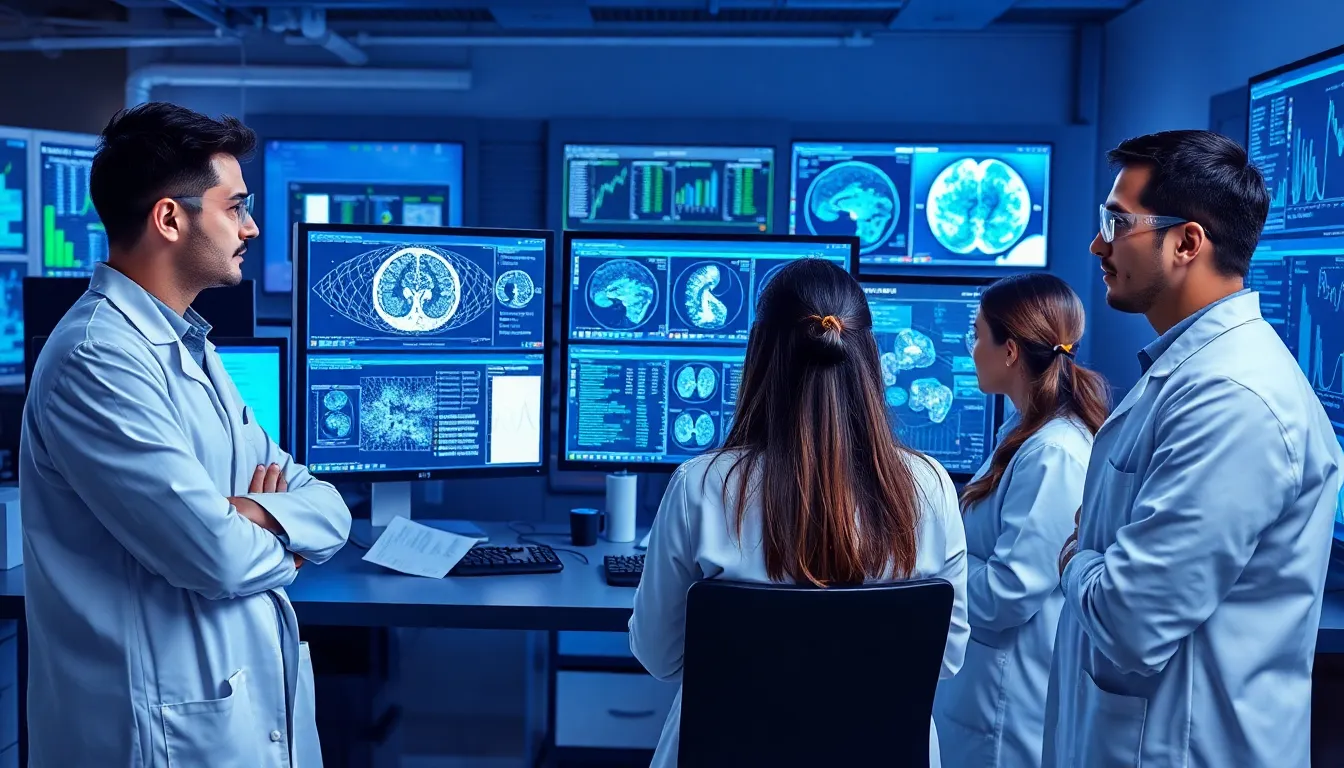In a world where science fiction meets reality, technology trends in life sciences are transforming the way we understand health and medicine. Imagine a future where diseases are diagnosed before symptoms even appear—sounds like magic, right? Well, it’s all thanks to advancements in artificial intelligence, big data, and genomics. These innovations are not just buzzwords; they’re reshaping the landscape of healthcare as we know it.
Table of Contents
ToggleOverview of Technology Trends in Life Sciences
Technological advancements significantly shape the life sciences sector. Artificial intelligence innovates data analysis, streamlining processes and enhancing decision-making in clinical settings. Big data analytics captures vast amounts of health information, revealing patterns that inform personalized patient care and treatment plans. Genomic technologies provide insights into individual genetic profiles, enabling tailored therapies that improve patient outcomes.
Telemedicine expands healthcare access, allowing remote consultations and monitoring through digital platforms. Wearable devices facilitate real-time health tracking, sharing critical data with healthcare providers for timely interventions. Robotics and automation support laboratory workflows, increasing efficiency and reducing human error during experiments and analyses.
Cloud computing enhances data storage solutions, providing scalable and secure environments for health data management. Cybersecurity measures become essential as organizations protect sensitive patient information from increasing cyber threats. Blockchain technology establishes a transparent system for tracking the provenance of medical products, ensuring safety and authenticity.
Interdisciplinary collaboration among tech companies, researchers, and healthcare providers fuels innovation. This collaborative approach accelerates the development of new drugs and therapies, addressing unmet medical needs. Emerging trends in digital health, such as mobile applications, reshape patient interactions and promote health literacy.
The integration of these technology trends leads to a more efficient and effective healthcare system. It’s crucial for professionals in life sciences to stay informed about these developments, as they continue to transform patient care and research methodologies. Each trend contributes to a holistic understanding of health and wellness, fostering advancements that improve overall population health outcomes.
Impact of Artificial Intelligence

Artificial intelligence significantly transforms life sciences by streamlining processes and enhancing decision-making. Innovations in AI, especially machine learning and predictive analytics, are driving this evolution.
Machine Learning Applications
Machine learning applications revolutionize data analysis in clinical research. Algorithms analyze vast datasets, identifying trends and predicting outcomes with remarkable accuracy. Researchers employ machine learning to enhance diagnostic processes and optimize treatment plans. Examples include identifying disease markers that facilitate early detection. Additionally, AI-driven tools assist in medical imaging, improving accuracy and reducing diagnostic errors. These technologies also support the development of personalized medicine by tailoring therapies to individual patient profiles.
Predictive Analytics in Drug Development
Predictive analytics significantly shorten drug development timelines. By using historical data and advanced algorithms, organizations make informed predictions about drug efficacy and safety. Drug developers analyze patient data in real-time, allowing immediate adjustments to trials based on projected responses. This approach increases the likelihood of successful outcomes while decreasing costs. Furthermore, predictive modeling informs decision-making about which compounds to advance, enhancing the efficiency of clinical trials. Overall, these capabilities enable more streamlined and effective drug development processes, ultimately benefiting patients and healthcare systems.
Advancements in Genomics
Genomic technology is undergoing rapid evolution, significantly reshaping the landscape of life sciences. These advancements enable more precise and personalized medical research and treatments.
CRISPR Technology
CRISPR technology stands at the forefront of genetic editing. This tool allows scientists to target and alter specific DNA sequences within organisms. With a streamlined process, researchers increasingly utilize CRISPR to develop treatments for genetic disorders like sickle cell anemia and cystic fibrosis. Several studies highlight its potential in creating disease-resistant crops, demonstrating versatility beyond human health. Its ease of use and cost-effectiveness contribute to widespread adoption in research labs, transforming genetic engineering approaches.
Next-Generation Sequencing
Next-generation sequencing (NGS) revolutionizes genetic analysis with rapid and high-throughput capabilities. This technology accelerates whole-genome sequencing, offering insights into complex diseases like cancer and diabetes. By improving accuracy and reducing costs, NGS enables researchers to analyze vast amounts of genetic data efficiently. Many clinical labs incorporate NGS for diagnostics, guiding treatment strategies tailored to individual patients. As data processing software advances, the interpretation of genomic sequences becomes faster, ensuring timely healthcare decisions.
Digital Health Innovations
Digital health innovations are transforming the healthcare landscape, enhancing accessibility and improving patient outcomes. This section explores key advancements in telemedicine and wearable health devices.
Telemedicine Solutions
Telemedicine solutions enable remote consultations, improving access to healthcare services. Patients can connect with healthcare providers from the comfort of their homes, reducing the need for in-person visits. These services include video conferencing and secure messaging, which facilitate ongoing communication. Evidence suggests that telemedicine has increased patient engagement, especially for those in rural areas. Additionally, regulatory changes are supporting the adoption of telehealth, streamlining processes for reimbursement. The integration of telehealth platforms with electronic health records enhances care coordination and improves clinical decision-making.
Wearable Health Devices
Wearable health devices monitor vital signs and provide real-time data, promoting proactive health management. Devices like smartwatches and fitness trackers collect information on heart rate, activity levels, and sleep patterns. This data empowers individuals to make informed lifestyle choices based on their health metrics. These technologies also allow for remote patient monitoring, enabling caregivers to receive alerts for potential health issues. Market research indicates a growing demand for these devices among consumers, driven by a desire for personalized health insights. Manufacturers are continually innovating, integrating advanced features such as ECG monitoring and sleep tracking capabilities.
Integration of Big Data
Big data analytics transforms life sciences by processing vast volumes of complex data sets. This integration enhances personalized patient care through deeper insights into health patterns. Researchers utilize big data to identify trends that guide treatment strategies, improving overall outcomes.
Machine learning algorithms analyze data from various sources, including electronic health records and clinical trials. These algorithms detect anomalies, enabling early disease detection even before symptoms appear. Predictive analytics forecasts patient responses to treatments, allowing for more tailored therapeutic approaches.
The use of big data extends beyond clinical settings; it also supports drug development processes. Researchers streamline trials by analyzing real-time patient data, significantly reducing time and costs associated with bringing products to market. This efficiency leads to faster approvals for new medications.
Cloud computing plays a crucial role in big data integration, offering scalable storage and processing capabilities. Researchers and healthcare providers access shared platforms for collaboration, fostering innovation in drug discovery. Interdisciplinary teams leverage these technologies, combining expertise to create solutions that address complex health challenges.
Security remains a priority in managing large data sets. Protecting sensitive patient information through advanced cybersecurity measures is essential to maintain trust in healthcare systems. Life sciences professionals continuously evaluate these technologies to ensure compliance with regulations.
Furthermore, big data analytics contributes to the development of wearable devices and telemedicine platforms. These innovations empower patients to monitor their health and engage in their treatment plans actively. Real-time data from wearables informs healthcare providers, leading to more informed clinical decisions.
The integration of big data in life sciences offers numerous advantages. Advancements in technology drive improvements in patient care and research methodologies, reshaping the healthcare landscape.
The ongoing evolution of technology in life sciences is reshaping healthcare in unprecedented ways. From artificial intelligence to genomic advancements and telemedicine, these innovations are not just enhancing patient care but also streamlining research processes.
As professionals in the field embrace these trends they’re positioned to drive significant improvements in diagnosis and treatment. The focus on interdisciplinary collaboration further accelerates the pace of innovation, ensuring that healthcare continues to evolve in response to emerging challenges.
Staying informed about these technological advancements is crucial for anyone involved in life sciences, as they hold the key to unlocking a healthier future for all.




